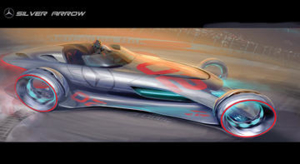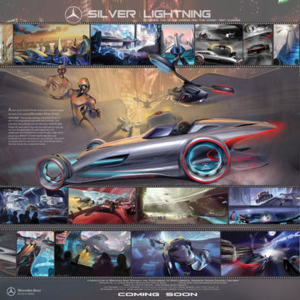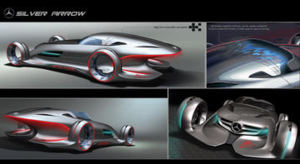NVIDIA Maximus Technology Helps Drive the Silver Arrow Mercedes-Benz Concept Car
NVIDIA Maximus Success Story
Car design is like a heady combination of art, high fashion, and engineering, requiring extreme degrees of creativity and aesthetic sensibility. Creative aesthetics are even more refined in the rarified world of concept car design, which explores the future form and function of automotive transport. Each year at the LA Auto Show in Los Angeles, design studios are invited to compete in a Design Challenge to create entire story lines based on and featuring extreme car designs.
For several years, the Advanced Design Center California, the North American research and development division of Mercedes-Benz, has competed in the LA Auto Show Design Challenge. This year, the Mercedes California studio added to its technology tools the NVIDIA® Maximus™ platform, transforming the studio’s workflow from a tedious, serial process to a parallel processing environment enabling multitasking with even the most compute-intensive steps.
“We always start with really ambitious ideas,” said Alan Barrington, the Mercedes-Benz Advanced Design Center California designer who, along with Jack Luttig, the vehicle’s designer, was given the responsibility of creating the animation. “Last year, we were forced to compromise, eliminating a lot of great features and dumbing things down because our computer technology wasn’t fast enough to perform the design and ray tracing we needed. This year was an entirely different story. The NVIDIA Maximus-powered system gave us the time to explore different options creatively, which shows in the quality of this year’s entry.”
CHALLENGE
For the Mercedes-Benz Advanced Design Center California, the LA Auto Show Design Challenge is a chance to flex creative muscles. But it’s far from an idle exercise in design for design’s sake.
“This competition is an important forum for trying out new software and new design technologies that we can apply to the development of our production cars,” said Christopher Rhoades, chief designer of the Mercedes-Benz Advanced Design Center California. “Internally, it also demonstrates to Mercedes executive management in Germany the role and value of satellite design studios like ours.”
Previously, the design studio used a quad-core CPU. Their design workflow began in 2D, using either paper or Adobe Photoshop or Autodesk Alias software. From there, they used Alias for 3D modeling and either Alias or Autodesk Maya for visualization.
“Visualization, actually ray tracing the surface of the car, was the most computer-intensive step,” said Barrington. “Photorealistic rendering– i.e., ray tracing–takes lots of calculations, and it could easily lock up the computer for a day. With hundreds of frames per visualization, and each frame taking 10 minutes to render, we needed hundreds of hours of rendering time each week.”
The ray-tracing process completely monopolized the studio’s computing systems meaning they were unavailable for any other work while rendering.
“Even trying to schedule rendering and visualization at night, often there was physically not enough time to get everything done,” said Barrington. “We had to make difficult choices about what couldn’t be ray-traced in the time available. As a result, for the 2010 competition we ran out of time to implement many of our concepts, which was frustrating.”
SOLUTION
The Mercedes-Benz Advanced Design Center California installed two NVIDIA Maximus systems on HP Z800 workstations. The NVIDIA Maximus platform brings together the industry-leading, professional 3D graphics capability of the ultra high-end NVIDIA Quadro® 6000 graphics processing unit (GPU) with the parallel-computing power of the new NVIDIA Tesla™ C2075 companion processor – enabling simultaneous 3D design, simulation, and visualization at the desktop.
On this system, the Mercedes –Benz designers run Autodesk 3ds Max, Bunkspeed’s Move/Drive with NVIDIA iray®, Maya, Alias, Photoshop, and Adobe After Effects software.
“With our Maximus-powered set-up, it’s like having a render farm with just two machines,” said Barrington. “Now when we create a photorealistic animation, we can design a scene and send it off to render in the background in Bunkspeed with iray, then immediately start working on the next scene, which is ready to ray-trace when the previous one is done. Bunkspeed and Maximus work perfectly together to deliver the power and speed we need to get an instant feel for how the scene will look. That’s a huge help in getting the look we want, faster.”
The Mercedes-Benz Advanced Design Center California’s entry for the 2011 LA Auto Show Design Challenge, titled Silver Lightning, pays homage to 125 years of automotive innovation and design excellence. The animation for the competition features a story with two techno characters that have achieved a unique harmony between safety and style: the iconic Mercedes-Benz Silver Arrow racecar and the underappreciated crash test dummy.
“The photorealistic animation is like a trailer for a movie, with high-impact, exciting scenes,” said Barrington. “We used the NVIDIA Maximus systems to model and ray trace the car and other characters not only for the animation, but also for a movie poster and stills we created. And in the opening scene of the trailer, where we were going for a lot of drama and where lighting was important, we were able to bring in a ray of sunlight that became a focal point of the scene. We literally could not have done this with our previous technology tools, because there was no way to design and render interactively, so not enough time to implement that kind of intricate lighting effect.”
IMPACT
“With the parallel processing capabilities enabled by the NVIDIA Maximus systems, we can now be 10 times more creative,” said Barrington. “In a given amount of time, we can explore so many different options and get to a better end product.”
The design studio also expects that these technology tools will be embraced by Mercedes-Benz’ engineers, who work with even larger data sets than the designers.
“Ray tracing and other compute-intensive processes no longer bring our workflow to a halt,” said Barrington. “While something is rendering on the NVIDIA Maximus system, we can continue doing 2D sketches, 3D modeling, and other tasks. We can stay productive not only on the animation for the competition, but also in our normal jobs.”
Those “normal jobs” entail designing both concept and production cars for Mercedes-Benz – as well as selling design ideas to the company’s headquarters.
“It’s important to provide talented designers with the right tools so they can express their abilities to the utmost,” said Rhoades. “NVIDIA Maximus technology enables us to do that, and it also makes it easier to communicate our new ideas and innovations to our German headquarters, to define our value as a satellite design studio.”
In the end, that value rests on the studio’s creative abilities.
“It’s the nature of our business that there are always changes,” said Barrington. “With the NVIDIA Maximus-powered environment, we can continue to refine and improve our design, right up to the last minute. We can stay efficient and multitask. We no longer have to settle for less or to compromise on our creativity.”


